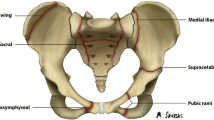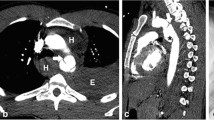Abstract
Background
The presumed mechanism of rib fractures in abuse is violent grasping of the torso causing anterior–posterior chest compression. We hypothesized an asymmetrical distribution of rib fractures in abused infants given the greater incidence of right-hand dominance within the general population.
Objective
The objective of this study was to characterize rib fractures in abused children, particularly sidedness; additionally, we evaluated the sidedness of other abusive skeletal fractures.
Materials and methods
We reviewed medical records from abused children (0–18 months old) with rib fractures. We also retrospectively reviewed their radiographs to determine characteristics of rib fractures (number, side, rib region, level, acuity) and other skeletal fractures (number, side, location), as well as differences in the distribution of rib and other skeletal fractures.
Results
A total of 360 rib fractures were identified on 273 individual ribs involving 78 abused children. Sixty-three children (81%) had multiple rib fractures. There was a significantly greater number of left-side rib fractures (67%) than right-side fractures (P<0.001). Fractures were most often identified in the posterior and lateral regions and mid level of the ribcage (Ribs 5 through 8). Fifty-four percent of subjects had other skeletal fractures; these non-rib fractures were also predominantly on the left side (P=0.006).
Conclusion
In our study of abused children, there was a higher incidence of rib fractures in the posterior, lateral and mid-level locations. Additionally, we found a predominance of left-side rib and other skeletal fractures. Further research is needed to understand whether factors such as perpetrator handedness are associated with these unequal distributions of fractures in abused children.










Similar content being viewed by others
References
Flaherty EG, Perez-Rosella JM, Levine MA, Hennrikus WL (2014) Evaluating children with fractures for child physical abuse. Pediatrics 133:e477–e489
Bulloch B, Schubert CJ, Brophy PD et al (2000) Cause and clinical characteristics of rib fractures in infants. Pediatrics 105:e48
Kleinman PK, Marks SC, Nimkin K et al (1996) Rib fractures in 31 abused infants: postmortem radiologic-histopathologic study. Radiology 200:807–810
Worn MJ, Jones MD (2007) Rib fractures in infancy: establishing the mechanisms of cause from the injuries — literature review. Med Sci Law 47:200–212
Kemp AM, Dunstan F, Harrison S et al (2008) Patterns of skeletal fractures in child abuse: systematic review. BMJ 337:a1518
Pandya NK, Baldwin K, Wolfgruber H et al (2009) Child abuse and orthopedic injury patterns: analysis at a Level I pediatric trauma center. J Pediatr Orthop 29:618–625
Maguire S, Cowley L, Mann M, Kemp A (2013) What does the recent literature add to the identification and investigation of fractures in child abuse: an overview of review updates 2005-2013. Evid Based Child Health 8:2044–2057
Paine CW, Fakeye O, Christian CW, Wood JN (2019) Prevalence of abuse among young children with rib fractures: a systematic review. Pediatr Emerg Care 35:96–103
Barsness KA, Cha ES, Bensard DD et al (2003) The positive predictive value of rib fractures as an indicator of nonaccidental trauma in children. J Trauma 54:1107–1110
Lonergan GJ, Baker AM, Morey MK, Boos SC (2003) Child abuse: radiologic-pathologic correlation. Radiographics 23:811–845
Garcia VF, Gotschall CS, Eichelberger MR, Bowman LM (1990) Rib fractures in children: a marker of severe trauma. J Trauma 30:695–700
Kleinman PK, Schlesinger AE (1997) Mechanical factors associated with posterior rib fractures: laboratory and case studies. Pediatr Radiol 27:87–91
Kleinman PK (2015) Bony thoracic trauma. In: Diagnostic imaging of child abuse, 3rd edn. Cambridge University Press, pp 164–207
Tsai A, Coats B, Kleinman PK (2012) Stress profile of infant rib in the setting of child abuse: a finite element parametric study. J Biomech 45:1861–1868
Armstrong C, Oldham J (1999) A comparison of dominant and non-dominant hand strengths. J Hand Surg Br 24:421–425
Cadzow SP, Armstrong KL (2000) Rib fractures in infants: red alert! The clinical features, investigations and child protection outcomes. J Paediatr Child Health 36:322–326
Barber I, Perez-Rossello JM, Wilson CR, Kleinman PK (2014) The yield of high-detail radiographic skeletal surveys in suspected infant abuse. Pediatr Radiol 45:69–80
Love JC, Derrick SM, Wiersema JM et al (2013) Novel classification system of rib fractures observed in infants. J Forensic Sci 58:330–335
Darling SE, Done SL, Friedman SD, Feldman KW (2014) Frequency of intrathoracic injuries in children younger than 3 years with rib fractures. Pediatr Radiol 44:1230–1236
Kleinman PK, Nimkin K, Rayder SM et al (1996) Follow-up skeletal surveys in suspected child abuse. AJR Am J Roentgenol 167:893–896
Sanchez TR, Lee JS, Coulter KP et al (2015) CT of the chest in suspected child abuse using submillisievert radiation dose. Pediatr Radiol 45:1072–1076
Pomeranz C, Barrera C, Zhu X, Servaes (2018) Accuracy of skeletal survey in evaluation of rib fractures compared to CT in the setting of accidental and non accidental trauma. Pediatr Radiol 48:S94
Author information
Authors and Affiliations
Corresponding author
Ethics declarations
Conflicts of interest
None
Additional information
Publisher’s note
Springer Nature remains neutral with regard to jurisdictional claims in published maps and institutional affiliations.
Rights and permissions
About this article
Cite this article
Kriss, S., Thompson, A., Bertocci, G. et al. Characteristics of rib fractures in young abused children. Pediatr Radiol 50, 726–733 (2020). https://doi.org/10.1007/s00247-019-04599-8
Received:
Revised:
Accepted:
Published:
Issue Date:
DOI: https://doi.org/10.1007/s00247-019-04599-8




